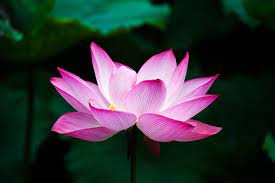
ブッダの重要な教え「八正道」の中でも、苦しみのない人生を送るための指針となる
「正見 (しょうけん)」を、タイの有名僧侶・アーチャン・チャーが解説――
バイリンガルで、どうぞ。
A guideline for living a life without sufferings in an important Buddhist teaching
“Noble Eightfold Path,” called “Right Understanding,” given commentaries by
Achaan Chah, a famous monk in Thailand――more to come both in English and
in Japanese.
Right understanding ultimately means nondiscrimination――seeing all people as
the same, neither good nor bad, neither clever nor foolish; not thinking that
honey is sweet and good and some other food is bitter.
正見 (サンマー・ディッティ) とは、究極的には無分別を意味します。無分別とは、
すべての人を善も悪もなく、賢いか愚かということもなく、平等に観 (かん) じること
です。言い換えるなら、「はちみつは甘くておいしいが、他の食べ物は苦い」など
ということは考えないということです。
Although you may eat several kinds of food, when you absorb and excrete them,
they all become the same. Is it one or many? Is a glass big? In relation to a little cup,
yes; when placed next to a pitcher, no.
あなたはさまざまな種類の食べ物を食べるかもしれません。けれども、あなたがその
食べ物を消化し、排泄するときには、それらはすべて同じものになります。その場合、
一と多、どちらが正解と言えるでしょうか? そこにあるグラスは、大きいと
言えますか? 小さなコップと比べた場合、その答えは「はい」ですね。けれども、
水差しと比べた場合、その答えは「いいえ」です。
Our desire and ignorance, our discrimination color everything in this way. This is
the world we create. Again, a pitcher is neither heavy nor light; we just feel that
it is one way or the other.
私たちの貪 (ローバ) と痴 (モーハ)、すべてのものを分別する際の色眼鏡は、こうして
生まれます。これが、私たちがつくり出した世界です。先ほどの例で言うと、水差しは
重くも軽くもありません。その区別は、私たちの見方によって生ずるものです。
Why is sugar sweet and water tasteless? It is just their nature. So too with thinking
and stillness, pain and pleasure――it is wrong understanding to want thinking
to cease. Sometimes there is thought, sometimes stillness. We must see that both are
by nature impermanent, unsatisfactory, not a cause for lasting happiness. But
if we continue to worry and think further, “I am suffering, I want to stop thinking,”
this wrong understanding only complicates things.
なぜ、砂糖は甘く、水は無味なのでしょうか? それは、それが砂糖や水の性質だから
です。そのことは、思考や静寂、楽 (スカ) や苦 (ドゥッカ) に対しても同じことが
言えます。ですから、思考を静めようとすることは間違った考えです。あるときには
思考があり、あるときには静寂があるのです。私たちはそれらの双方が
無常 (アニッチャ)、苦であり、永遠に続く幸福ではないということを理解しなくては
なりません。しかし、もし私たちが心配を続け、さらに「私は苦しんでいる。思考を
止めたい」と考えるのなら、この間違った理解は、物事をより複雑にするだけです。
At times, we may feel that thinking is suffering, like a thief robbing us of the present.
What can we do to stop it? In the day, it is light; at night it is dark. Is this itself suffering?
時折、私たちは思考を「今、ここ」の瞬間を盗んでいく泥棒であるかのように考え、
苦であると感じるかもしれません。では、私たちは、どのようにして思考を止めること
ができるのでしょうか? 日中には光があり、夜には闇があります。このこと自体は
苦しみでしょうか?
Only if we compare the way things are now with other situations we have known
and wish it were otherwise. Ultimately things are just as they are――only
our comparison cause us to suffer.
私たちが物事を比較するときに限り、今生じていることと、あり得たかもしれない他の
場合は分かたれ、他のようであってほしいと願うことが可能になります。しかし、
究極的には、現象とはあるがままのものであり、私たちが物事を比較することだけが
苦しみを引き起こしているのです。
Still enlightenment dose not mean to become dead like a Buddha statue.
One who is enlightened thinks also but knows the process as impermanent,
unsatisfactory, and empty of self. We who practice must see these things clearly.
悟りの寂静とは、仏像のように死んだようになることを意味しているわけでは
ありません。悟りを開いた人も物を考えることはありますが、無常・苦・
無我 (アナッター) のプロセスをよく理解しています。修行者である私たちは、これらの
ことを明確に理解しなければなりません。
We need to investigate suffering and stop its causes. If we do not see it, wisdom
can never arise. There should be no guesswork, we must see things exactly
as they are――feelings are just feelings, thoughts are just thoughts. This is
the way to end all our problems.
私たちは苦についてよく理解をし、その原因をやめる必要があります。もし、私たちが
それを観察しないのなら、智慧は決して生ずることはありません。当てずっぽうでは
なしに、感情は感情と、思考は思考と、現象をありのまま正確に理解しなければ
なりません。これこそが、私たちの問題すべてに終止符を打つ道なのです。
My second anthology is published now.
Please order it from Amazon if you are interested in.
私の2番目の詩集が、現在、出版されています。
興味のある方は、アマゾンでご購入をお願いいたします。
■プライバシー・ポリシー
当ブログは、Amazon.co.jpを宣伝しリンクすることによってサイトが紹介料を獲得
できる手段を提供することを目的に設定されたアフィリエイト宣伝プログラムである、
Amazonアソシエイト・プログラムの参加者です。このプログラムにおいて、
第三者がコンテンツおよび宣伝を提供し、ユーザーからの情報を収集し、訪問者の
ブラウザーにクッキーを設定することがあります。プログラムにおいて情報の
扱いについてはAmazon.co.jpプライバシー規約をご確認ください。










